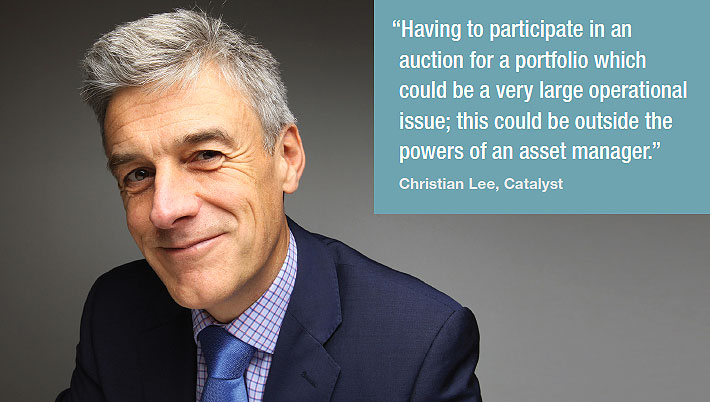Few asset managers are buying into the direct CCP model. Fred Maple reports.
The fanfare with which central counterparties (CCPs) launched new membership categories for buy-side firms in over-the-counter (OTC) markets looked for a time like it might foreshadow a flood of asset managers ditching certain elements of their existing broker relationships in favour of signing direct agreements with the CCPs.
However, this sudden shift has been more of a spluttering start, in part due to the many complications that asset managers have to navigate in signing agreements directly with the clearing houses. Eurex, ICE and LCH.Clearnet all offer a variation of membership for the buy side in Europe, but all only have a handful of participants combined using the services.
Eurex has launched its service in repo and interest rate swaps, LCH via its RepoClear CCP, and ICE Clear Europe for credit default swaps. Eurex has signed up Dutch asset manager PGGM, while Insight Investment was the first asset manager to clear through RepoClear’s new model.

“If you fundamentally change how the market works, it takes time,” says Matthias Graulich, chief strategy officer at Eurex Clearing, which launched ISA Direct in the summer of 2016. “When we started, it was clear that ISA Direct wouldn’t have massive traction straight away. Now we are working to bring on two large buy-side firms which will take our membership to five firms, which we expect will lead to greater take-up from the wider community.”
The main hurdles
Issues range widely on why it has been hard to get asset managers on-board. Joining a CCP comes with quite a few obligations of membership, which do not start and end in needing to stump up fees. Default fund contributions can be quite a deterrent for some businesses in terms of how they deal with that burden.

“It’s quite hard for an asset manager to swallow, over and above the cost of clearing, the additional default fund contribution that can move up and down depending on factors which are outside the fund’s control,” says Christian Lee, a consultant at post-trade specialist Catalyst. However, the biggest issue is the obligations that come with the default management process, he notes.
“If there is an issue with a CCP member, there are certain obligations which are hardwired into the rules with respect to providing bids in a hedging round and then, most significantly, having to participate in an auction for a portfolio which could be a very large operational issue. This could be outside the powers of an asset manager and might even be prohibited by terms of their charters.”
This can be made harder if an asset manager is acting on behalf of a number of different funds – like pension funds – which could result in separate agreements needing to be signed for all the underlying accounts. Some types of buy-side firms are not allowed to contribute to loss mutualisation programmes, either.
Real benefits
In order to get around these sticking points, CCPs have developed different models that aim not just to inhibit the asset managers’ responsibilities at the clearing house – such as the default fund contributions and default management obligations – but this also can reduce banks’ balance sheet costs associated with serving these clients via a traditional clearing broker model. Those banks that see the savings from a cost of capital perspective might well value that over and above any talk of disintermediation.
“We’re not disintermediating the role of the clearing broker, but simply changing the role,” says Graulich. “Some clearing brokers have started to appreciate the return of capital on the new model versus the traditional client clearing model. On the other hand, the absolute revenue the broker is generating is likely to decrease via this new model, as a significant portion of the capital charge is taken out. So, depending on the target the broker has, whether in absolute revenue or return on capital, they will have a certain incentive as to whether to support it or not.”
As a result, Graulich says Eurex has three clearing brokers actively approaching clients to offer ISA Direct both for Repo and OTC interest rate derivatives. Both Eurex and LCH have launched a type of buy-side membership in repo, which has become a costlier balance sheet activity for banks to facilitate since post-crisis rules like the leverage ratio have come into effect.
“In repo, bank intermediaries benefit from reduced balance sheet usage and enhanced netting process when the buy side becomes a member of a CCP, and the transactional relationship is with the CCP. A sponsored access model sees reduced balance sheet and capital implications to those of guaranteed transactions in a normal clearing broker relationship,” says
Elkins believes the capital savings could also ultimately lead to cheaper execution and better pricing for clients, and has two pension funds using the RepoClear buy-side service already.
Alternative to direct membership
Not all CCPs have created a form of direct membership. ICE Clear Europe developed a sponsored principal model for buy-side firms in 2013 wanting to individually segregate funds, which Mark Woodward, head of corporate development at the CCP, dubs an “enhanced client protection model”.

“It’s a client clearing model where clients are a sponsored principal and are sponsored by a full clearing member,” he says. “The sponsor remains fully liable in the event of default of the sponsored principal, but the sponsored principal has its own position and asset account at ICE Clear Europe, so it can provide margin directly to us.”
In a default situation, the sponsor manages that with the CCP and if any extra margin is needed, then the sponsor is fully liable.
“Because the sponsored principal has positions directly at the CCP, reporting is easier as positions are at the CCP, and if the sponsor itself defaults, then ICE Clear Europe could run their positions for a short period of time while the client finds another sponsor or transfers the position to another clearing member,” he says.
Need for collaboration
For those clearing brokers concerned that they are being disintermediated by CCPs, Woodward argues this type of model allows banks to rest assured this is not the aim of the CCP, while buy-side firms can be happy that cost is likely to be lower, too.
For example, assets can be passed directly to a CCP, which in theory helps the balance sheet of the clearing broker. The clearing broker is also posting to the guarantee fund, but there is a separate calculation so there is a way of knowing what portion is attributable to that sponsored principal.
“The crucial element of this model is that it doesn’t change the risk profile at the CCP,” he says. “So although clients are closer to full membership, they don’t have to make contributions to the guaranty fund. In the sponsored principal model, the clearing member is fully liable for the client in the event of a client default. In other structures there are limitations in terms of the liability of the clearing member, which might be helpful from a capital perspective, but it changes the risk dynamic for other clearing members.”
What may ultimately see an uptick from the paltry number of buy-side firms taking up new membership models for CCPs in Europe is the continued inclusion of firms inside the mandatory clearing obligation.
“The clearing mandate for OTC CDS in Europe is less advanced than in the US, so it’s early days,” says Woodward. “The obligation for Category 2 firms started in August 2017, so smaller banks and larger buy-side firms came within the mandate at that point, and we saw an up-tick in terms of client clearing and use of individually segregated accounts. Category 3 and 4 is where the majority of pension funds and others will be included in the CDS clearing mandate, and that doesn’t start until 2019.”
©TheDESK 2018
TOP OF PAGE




















